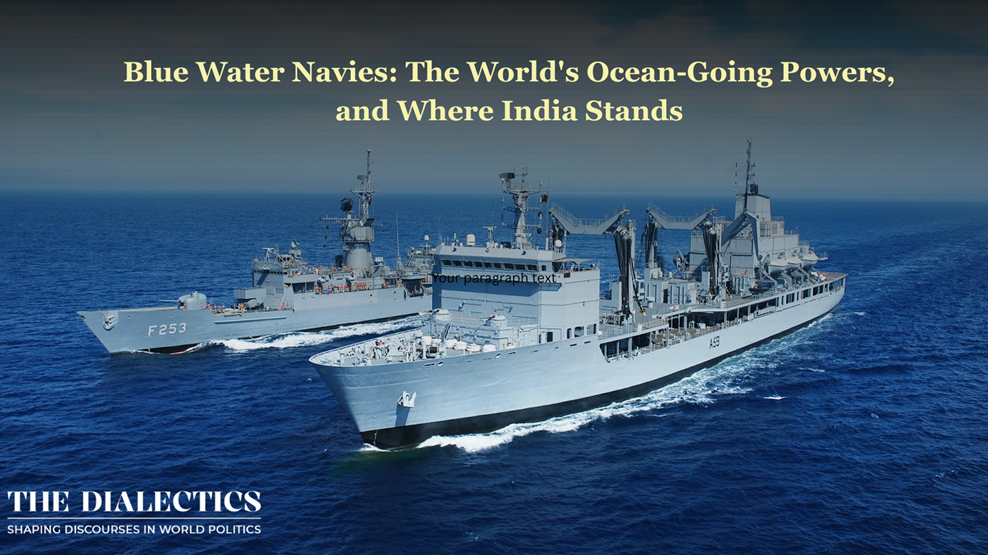For most of human history, navies were tied closely to the shorelines of their nations. Ships patrolled coasts, protected harbors, and fought short-range battles. But in the modern era, some navies have broken free of those constraints, becoming true ocean-going forces with the ability to operate far from home for extended periods. These are known as blue water navies — the ultimate symbol of maritime strength and global reach.
What exactly is a Blue Water Navy?
The term “blue water” comes from the deep blue of the open ocean, far from the brown or green coastal waters. At its simplest, a blue water navy is one that can operate at least 200 nautical miles (about 320 kilometers) from its home shores. But this is more than just distance — it’s about the ability to project power, sustain operations, and maintain presence anywhere in the world.
In Western naval doctrines, the definition often includes:
- The ability to operate globally, not just regionally.
- Possession of aircraft carriers or large-deck amphibious assault ships.
- A fleet of nuclear-powered submarines for strategic deterrence.
- Supply ships, tankers, and logistics vessels to sustain operations far from home.
- Secure overseas bases or access agreements for replenishment.
Admiral Jayant Nadkarni, who led the Indian Navy between 1987 and 1990, captured the political meaning of this idea when he said:
“The legitimate use of a Blue Water Navy is power projection which is necessary for a power like India.”
Simply put, a blue water navy is as much a political tool as it is a military one. It is about showing the flag far from home, protecting sea lanes, evacuating citizens during crises, and signaling influence to friend and foe alike.
Current Blue Water Navies in the World
Now, we have understood the term, it will be justified to move to understand who are the nations currently can be considered as the Blue Navy in the world. Only a handful of nations today truly operate blue water navies in the full sense of the term. These are not just large fleets, but forces with proven ability to sustain themselves globally for months at a time.
United States Navy
The gold standard of blue water capabilities, the US Navy operates 11 nuclear-powered aircraft carriers, a large fleet of nuclear submarines, and a global network of bases. It can project power to any ocean, at any time. An aircraft carrier does not sail alone in high seas; rather it’s a fleet also known as a carrier strike group composed of an aircraft carrier and typically includes a variety of other warships and support vessels, including cruisers, destroyers, frigates, submarines, and supply ships. Imagine 11 fleets like this in the ocean and then try to make sense of their capabilities.
People’s Liberation Army Navy (China)
The second most capable and standard blue navy power is China. In the last two decades, China has rapidly transformed from a coastal defence force to a major ocean-going power. It now operates two aircraft carriers, Liaoning and Shandong. A third carrier, Fujian, is under sea trial, and a fourth, a nuclear-powered carrier, is under construction. China has also increased its nuclear submarine fleet, established its first overseas base in Djibouti, and currently, China has the highest number of vessels in the world.
Royal Navy (United Kingdom)
Though smaller than in its imperial heyday, the Royal Navy maintains global reach with aircraft carriers like HMS Queen Elizabeth, nuclear submarines, and overseas facilities in places like Bahrain, Gibraltar, and the Falklands. These submarines have capabilities to roam under the deep sea for months without being detected or coming up to the surface.
French Navy
France operates the nuclear-powered aircraft carrier Charles de Gaulle and maintains global presence through overseas territories and naval bases in the Indian and Pacific Oceans.
Russian Navy
Russia’s blue water capability has declined since the Soviet era but still maintains nuclear submarines, long-range surface combatants, and forward deployments, particularly in the Mediterranean.
Indian Navy
India is also involved in that race and is playing aggressively. India’s fleet now includes two aircraft carriers, INS Vikrant and INS Vikramaditya, nuclear-powered ballistic missile submarines (SSBNs), and long-range surface combatants, allowing for regional and increasingly global operations. However, knowing the size of our nation and the vast ocean to the south, India has to build more submarines, aircraft and other battle ships to match its regional and global rivals.
Japan Maritime Self-Defence Force and Italian Navy also have substantial regional presence, but there is a considerable debate on their Blue water capabilities. Japan fields large helicopter carriers, advanced destroyers, and submarines capable of long-range deployments, especially in the Pacific and Indian Oceans. While Italy’s navy is smaller in scale, but operates aircraft carriers and modern frigates, maintaining a presence in the Mediterranean and beyond.
What It Takes to Become a Blue Water Navy
Transforming from a brown water or green water force (coastal and near-sea operations) into a blue water navy is a long, expensive, and strategic process. It requires a combination of technology, infrastructure, and political will.
Capital ships such as aircraft carriers or large amphibious ships are the hallmark of blue water status, providing air cover and strike capability far from home. Nuclear submarines are essential for strategic deterrence and for operating without dependence on surface fleets. Fleet logistics, including long-range replenishment ships, tankers, and repair vessels, keep the fleet supplied with fuel, ammunition, and food thousands of miles from home. Global basing, either through permanent overseas bases or basing agreements with friendly nations, is essential for rest, repair, and resupply. Advanced training and doctrine ensure sailors and officers are prepared for long deployments, joint operations, and combat in unfamiliar waters. A sustainable defence budget is crucial, as blue water fleets are expensive to build and even more expensive to maintain, requiring continuous funding.
India’s Blue Water Journey
India’s ambition to move from a brown water to a blue water navy gained real momentum in the late 1990s, and by 2003 the Navy had adopted the slogan “Tacking to the Blue Waters,” reflecting both a vision and a strategic necessity. In 2006, on Navy Day, it publicly declared this transformation goal. Since then, progress has been steady: the fleet now includes two aircraft carriers, the Russian-origin INS Vikramaditya and the indigenously built INS Vikrant along with the nuclear-powered ballistic missile submarine INS Arihant and leased Russian SSNs, supported by modern destroyers, frigates, and corvettes equipped with long-range missiles.
The Navy operates P-8I Poseidon aircraft for maritime surveillance and anti-submarine warfare and enjoys basing access in Oman, Singapore, Mauritius, and Madagascar. Strategically, India’s location astride the Indian Ocean’s busiest sea lanes gives it both an opportunity and an obligation to protect vital trade routes, deter hostile presence, and ensure maritime dominance in its near-seas.
However, challenges remain: to project sustained power, India needs at least three operational carriers and a larger fleet of nuclear attack submarines, as well as more permanent overseas bases. Budgetary constraints continue to slow expansion, with expensive naval programs competing for resources against other services, and despite advances in indigenous production, dependence on foreign suppliers for critical systems persists.
How Far Is India from a Full Blue Water Status?
India today is a credible regional maritime power with proven ability to operate across the Indian Ocean and project presence into the Western Pacific, but full blue water status in the global, sustained, and continuous sense remains a work in progress. The Indian Navy has ambitious plans under its Maritime Capability Perspective Plan to field 200 ships, 500 aircraft, and 24 attack submarines, yet currently operates around 132 ships, 220 aircraft, and 15 submarines. Its single operational aircraft carrier, INS Vikramaditya, falls short of the minimum three carriers needed for uninterrupted power projection, and a 65,000-ton CATOBAR carrier with electric propulsion remains on the drawing board.
Budgetary constraints pose a major hurdle, the Navy receives the smallest share of defence spending among the three services, with just 15% of military expenditure compared to 23–30% for Quad peers, slowing both acquisitions and indigenous shipbuilding. While India has five major shipyards, chronic delays, bureaucratic inefficiencies, and long construction cycles hinder expansion, and many new inductions merely replace retiring platforms.
Cybersecurity lapses, outdated production methods, and delays like the 36 defects that postponed the second Kalvari-class submarine reveal systemic challenges. Still, progress is evident as the Navy has mastered arrested landings and ski-jump takeoffs, deployed the Naval LCA for trials, expanded logistics access agreements, and enhanced domain awareness through the Information Fusion Centre. To truly match established blue water powers, India must not only expand fleet size but also invest in technological self-reliance, advanced training, overseas basing, and rapid capability enhancement anchored in indigenous shipbuilding. In the Indian Ocean, India is already dominant; in the Indo-Pacific, it can deploy for limited durations; but for truly global reach, sustained investment and strategic clarity will be essential.
Why Blue Water Capability Matters
In the 21st century, a nation’s influence is not only measured in economic or military terms on land but also by its ability to control and secure the seas. For India, a blue water navy is not a luxury but it’s a necessity, given its trade dependence, its location at the heart of the Indian Ocean, and the growing naval presence of China.
A true blue water capability allows India to:
- Protect trade and energy supply routes.
- Respond to crises and evacuate citizens from conflict zones.
- Provide humanitarian assistance in distant regions.
- Strengthen alliances and deter adversaries.
- Project national prestige and diplomatic influence.
Finally, Blue water navies are the ultimate maritime statement symbolsing reach, resilience, and national ambition. Only a few nations have them today, and fewer still have maintained them over decades. India has made impressive strides in the past twenty-five years, moving decisively from a coastal defense mindset to an oceanic vision. But the journey is far from over.
To complete its transformation, India will need to invest steadily in ships, submarines, bases, and people and perhaps most importantly, in the political will to use its navy as a tool of both national defense and global influence.




